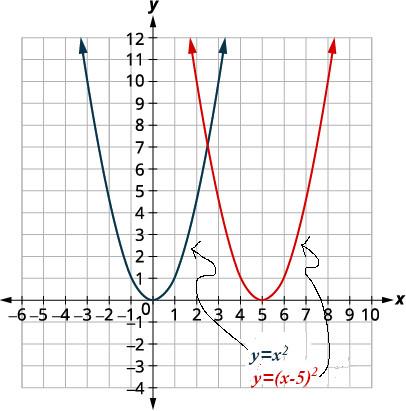7.6: Graph Quadratic Equations Using Transformations
- Page ID
- 67023
By the end of this section, you will be able to:
- Graph quadratic expressions of the form \(y=x^{2}+k\)
- Graph quadratic expressions of the form \(y=(x−h)^{2}\)
- Graph quadratic expressions of the form \(y=ax^{2}\)
- Graph quadratic expressions using transformations
- Find a quadratic expressions from its graph
Before you get started, take this readiness quiz.
- Graph the expressions \(y=x^{2}\) by plotting points.
- Factor completely: \(y^{2}−14y+49\).
- Factor completely: \(2x^{2}−16x+32\).
Graph Quadratic Expressions of the Form \(y=x^{2}+k\)
In the last section, we learned how to graph quadratic expressions using their properties. Another method involves starting with the basic graph of \(y=x^{2}\) and ‘moving’ it according to information given in the equation. We call this graphing quadratic equations using transformations.
In the first example, we will graph the quadratic equation \(y=x^{2}\) by plotting points. Then we will see what effect adding a constant, \(k\), to the equation will have on the graph of the new equation \(y=x^{2}+k\).
Graph \(y=x^{2}\), \(y=x^{2}+2\), and \(y=x^{2}−2\) on the same rectangular coordinate system. Describe what effect adding a constant to the right side of the equation has on the basic parabola.
Solution:
Plotting points will help us see the effect of the constants on the basic \(y=x^{2}\) graph. We fill in the chart for all three equations.
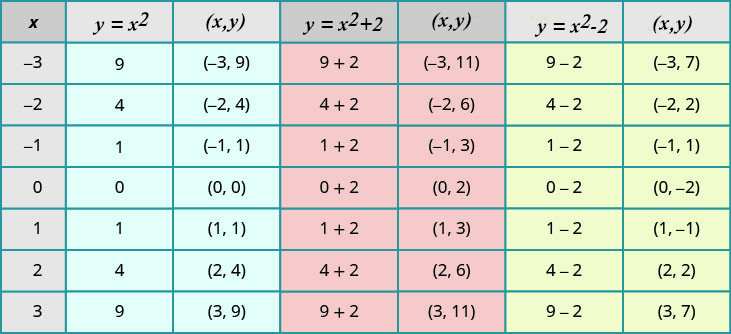
The \(y\)-coordinates of the solutions to \(y=x^2+2\) are two more than the \(y\)-coordinates of the solutions to \(y=x^2\) values. Also, the \(y\)-coordinates of the solutions to \(y=x^2-2\) values are two less than the \(y\)-coordinates of the solutions to \(y=x^2\) values. Now we will graph all three equations on the same rectangular coordinate system.
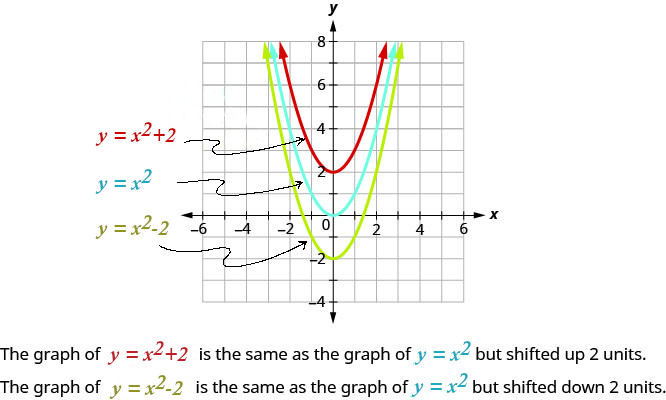
The graph of \(y=x^{2}+2\) is the same as the graph of \(y=x^{2}\) but shifted up \(2\) units.
The graph of \(y=x^{2}−2\) is the same as the graph of \(y=x^{2}\) but shifted down \(2\) units.
- Graph \(y=x^{2}, y=x^{2}+1,\) and \(y=x^{2}-1\) on the same rectangular coordinate system.
- Describe what effect adding a constant to the equation has on the basic parabola.
- Answer
-
a.
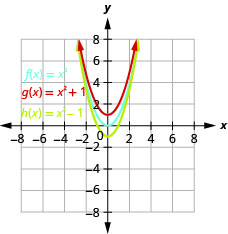
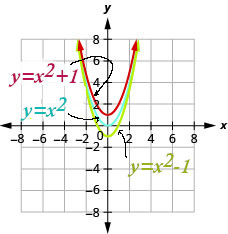
Figure 9.7.3 b. The graph of \(y=x^{2}+1\) is the same as the graph of \(y=x^{2}\) but shifted up \(1\) unit. The graph of \(y=x^{2}−1\) is the same as the graph of \(y=x^{2}\) but shifted down \(1\) unit.
- Graph \(y=x^{2}, y=x^{2}+6,\) and \(y=x^{2}-6\) on the same rectangular coordinate system.
- Describe what effect adding a constant to the equation has on the basic parabola.
- Answer
-
a.
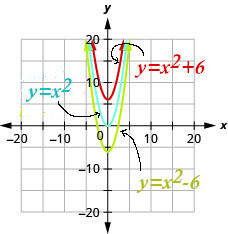
Figure 9.7.4 b. The graph of \(y=x^{2}+6\) is the same as the graph of \(y=x^{2}\) but shifted up \(6\) units. The graph of \(y=x^{2}-6\) is the same as the graph of \(y=x^{2}\) but shifted down \(6\) units.
The last example shows us that to graph a quadratic equation of the form \(y=x^{2}+k\), we take the basic parabola graph of \(y=x^{2}\) and vertically shift it up \((k>0)\) or shift it down \((k<0)\).
This transformation is called a vertical shift.
Graph a Quadratic equation of the Form \(y=x^{2}+k\) Using a Vertical Shift
The graph of \(y=x^{2}+k\) shifts the graph of \(y=x^{2}\) vertically \(k\) units.
- If \(k>0\), shift the parabola vertically up \(k\) units.
- If \(k<0\), shift the parabola vertically down \(|k|\) units.
Now that we have seen the effect of the constant, \(k\), it is easy to graph equations of the form \(y=x^{2}+k\). We just start with the basic parabola of \(y=x^{2}\) and then shift it up or down.
It may be helpful to practice sketching \(y=x^{2}\) quickly. We know the values and can sketch the graph from there.
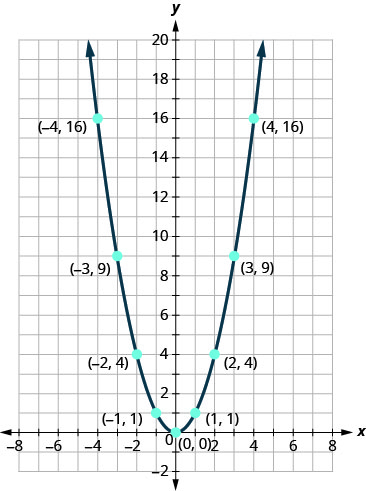
Once we know this parabola, it will be easy to apply the transformations. The next example will require a vertical shift.
Graph \(y=x^{2}−3\) using a vertical shift.
Solution:
| We first draw the graph of \(y=x^{2}\) on the grid. | 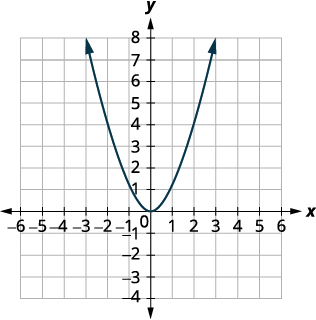 |
| Determine \(k\). |
\(y=x^2+k\) \(y=x^2-3\) |
 |
|
| Shift the graph \(y=x^{2}\) down \(3\). | 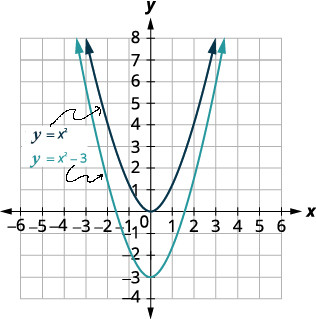 |
Graph \(y=x^{2}−5\) using a vertical shift.
- Answer
-
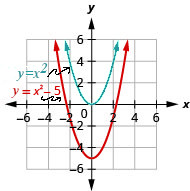
Graph \(y=x^{2}+7\) using a vertical shift.
- Answer
-
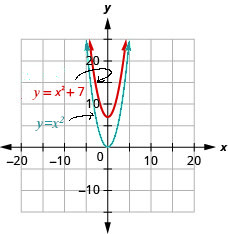
Graph Quadratic equations of the Form \(y=(x-h)^{2}\)
In the first example, we graphed the quadratic equation \(y=x^{2}\) by plotting points and then saw the effect of adding a constant \(k\) to the right side of the equation (or, equivalently, subtracting \(k\) from \(y\)) had on the resulting graph of the new equation \(y=x^{2}+k\).
We will now explore the effect of subtracting a constant, \(h\), from \(x\) has on the resulting graph of the new equation \(y=(x−h)^{2}\).
Graph \(y=x^{2}, y=(x-1)^{2},\) and \(y=(x+1)^{2}\) on the same rectangular coordinate system. Describe what effect adding a constant to the equation has on the basic parabola.
Solution:
Plotting points will help us see the effect of the constants on the basic \(y=x^{2}\) graph. We fill in the chart for all three equations.
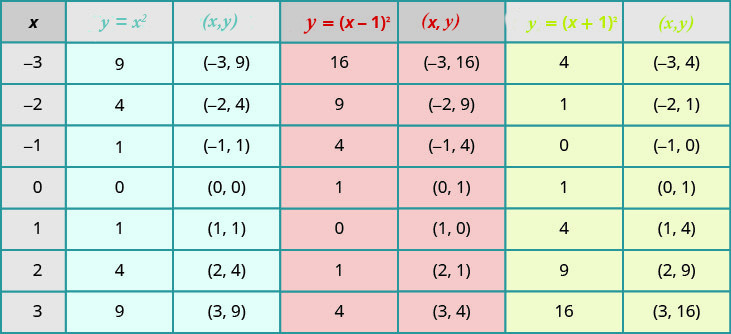
The \(y\)-coordinates share the common numbers \(0, 1, 4, 9\), and \(16\), but are shifted, in that they correspond to different \(x\)-coordinates in the different cases.


- Graph \(y=x^{2}, y=(x+2)^{2},\) and \(y=(x-2)^{2}\) on the same rectangular coordinate system.
- Describe what effect adding a constant to the \(x\) variable has on the basic parabola.
- Answer
-
a.
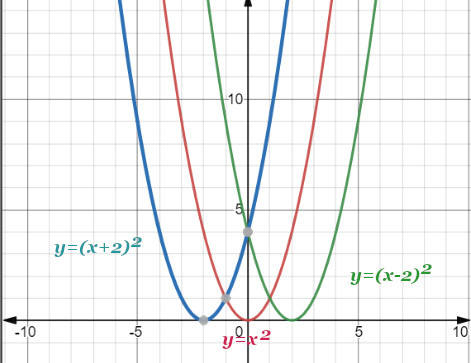
b. The graph of \(y=(x+2)^{2}\) is the same as the graph of \(y=x^{2}\) but shifted left \(2\) units. The graph of \(y=(x−2)^{2}\) is the same as the graph of \(y=x^{2}\) but shifted right \(2\) units.
- Graph \(y=x^{2}, y=x^{2}+5,\) and \(y=x^{2}-5\) on the same rectangular coordinate system.
- Describe what effect adding a constant to the equation has on the basic parabola.
- Answer
-
a.
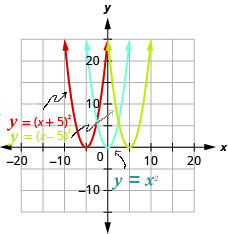
b. The graph of \(y=(x+5)^{2}\) is the same as the graph of \(y=x^{2}\) but shifted left \(5\) units. The graph of \(y=(x-5)^{2}\) is the same as the graph of \(y=x^{2}\) but shifted right \(5\) units.
The last example shows us that to graph a quadratic equation of the form \(y=(x−h)^{2}\), we take the basic parabola graph of \(y=x^{2}\) and shift it left \((h>0)\) or shift it right \((h<0)\).
This transformation is called a horizontal shift.
Graph a Quadratic equation of the Form \(y=(x-h)^{2}\) Using a Horizontal Shift
The graph of \(y=(x-h)^{2}\) shifts the graph of \(y=x^{2}\) horizontally \(h\) units.
- If \(h>0\), shift the parabola horizontally left \(h\) units.
- If \(h<0\), shift the parabola horizontally right \(|h|\) units.
Now that we have seen the effect of the constant, \(h\), it is easy to graph equations of the form \(y=(x−h)^{2}\). We just start with the basic parabola of \(y=x^{2}\) and then shift it left or right.
The next example will require a horizontal shift.
Graph \(y=(x−5)^{2}\) using a horizontal shift.
Solution:
| We first draw the graph of \(y=x^{2}\) on the grid. | 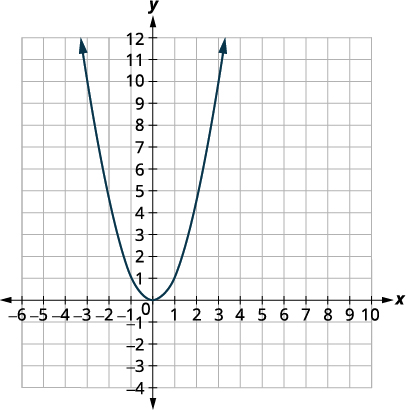 |
| Determine \(h\). |
\(y=(x-h)^2\) \(y=(x-5)^2\) |
| \(h=5\) | |
| Shift the graph \(y=x^{2}\) to the right \(5\) units. |
|
Graph \(y=(x−4)^{2}\) using a horizontal shift.
- Answer
-
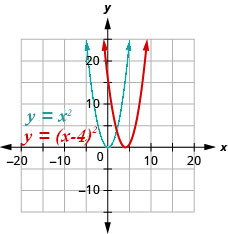
Graph \(y=(x+6)^{2}\) using a horizontal shift.
- Answer
-
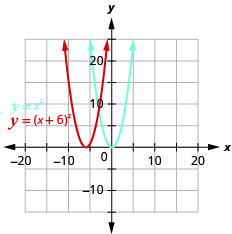
(Note that you may also view the consideration of the equation \(y=x^2+k\) as \(y-k=x^2\) and think of this as a shift along the \(y\)-axis. Viewing it this way allows for a similar approach to the transformation of graphs of equations formed by adding (or subtracting) constants to (or from) variables.)
Now that we know the effect of the constants \(h\) and \(k\), we will graph a quadratic equation of the form \(y=(x-h)^{2}+k\) by first drawing the basic parabola and then making a horizontal shift followed by a vertical shift. We could do the vertical shift followed by the horizontal shift, but most students prefer the horizontal shift followed by the vertical.
Graph \(y=(x+1)^{2}-2\) using transformations.
Solution:
This equation will involve two transformations and we need a plan.
Let’s first identify the constants \(h, k\).
\(y=(x-h)^2+k\)
\(y=(x-(-1))^2-2\)
\(h=-1, k=-2\)
The \(h\) constant gives us a horizontal shift and the \(k\) gives us a vertical shift.

We first draw the graph of \(y=x^{2}\) on the grid.


Graph \(y=(x+2)^{2}-3\) using transformations.
- Answer
-
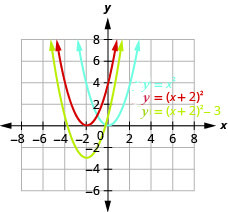
Graph \(y=(x-3)^{2}+1\) using transformations.
- Answer
-
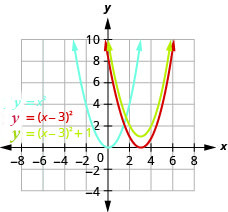
Graph Quadratic Equations of the Form \(y=ax^{2}\)
So far we graphed the quadratic equation \(y=x^{2}\) and then saw the effect of including a constant \(h\) or \(k\) in the equation had on the resulting graph of the new equation. We will now explore the effect of the coefficient \(a\) on the resulting graph of the new equation \(y=ax^{2}\).
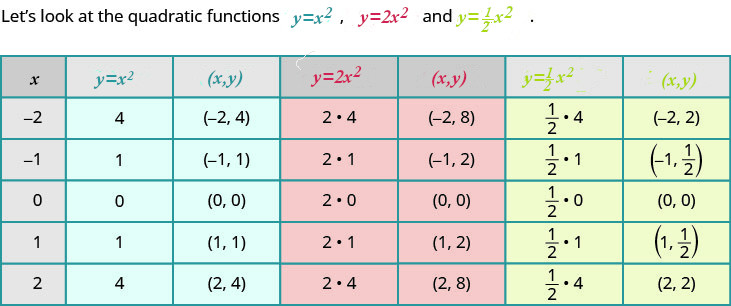
If we graph these equations, we can see the effect of the constant \(a\), assuming \(a>0\).
2.jpg?revision=1)
The graph of the equation \(y=2x^2\) is "skinnier" than the graph of \(y=x^2\).
The graph of the equation \(y=\dfrac12 x^2\) is "wider" than the graph of \(y=x^2\).
To graph a equation with constant \(a\) it is easiest to choose a few points on \(y=x^{2}\) and multiply the \(y\)-coordinates by \(a\).
Graph of a Quadratic equation of the Form \(y=ax^{2}\)
The coefficient \(a\) in the equation \(y=ax^{2}\) affects the graph of \(y=x^{2}\) by stretching or compressing it.
- If \(0<|a|<1\), the graph of \(y=ax^{2}\) will be “wider” than the graph of \(y=x^{2}\).
- If \(|a|>1\), the graph of \(y=ax^{2}\) will be “skinnier” than the graph of \(y=x^{2}\).
Graph \(y=3x^{2}\).
Solution:
We will graph the equations \(y=x^{2}\) and \(y=3x^{2}\) on the same grid. We will choose a few points on \(y=x^{2}\) and then multiply the \(y\)-values by \(3\) to get the points for \(y=3x^{2}\).
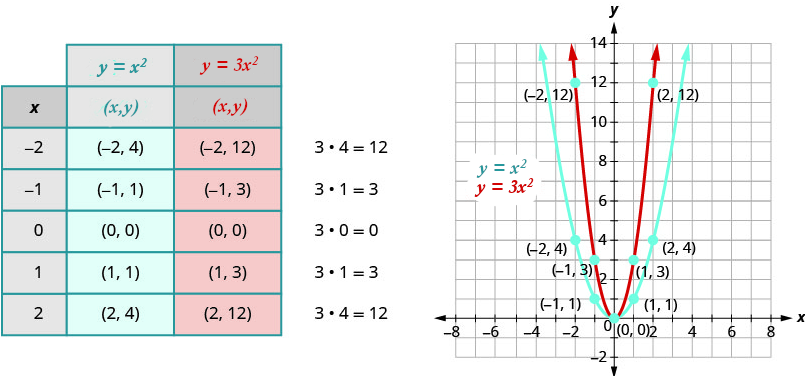
Graph \(y=-3x^{2}\).
- Answer
-
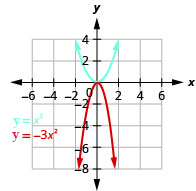
Graph \(y=2x^{2}\).
- Answer
-
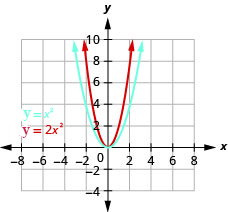
Graph Quadratic equations Using Transformations
We have learned how the constants \(a, h\), and \(k\) in the equations, \(y=x^{2}+k, y=(x−h)^{2}\), and \(y=ax^{2}\) affect their graphs. We can now put this together and graph quadratic equations \(y=ax^{2}+bx+c\) by first putting them into the form \(y=a(x−h)^{2}+k\) by completing the square. This form is sometimes known as the vertex form or standard form.
We must be careful to both add and subtract the number to the expression to complete the square. We cannot add the number to 'both sides' (both sides of what?) as we did when we completed the square with quadratic equations. Note that we could also add and subtract a number from the same side in the case of the quadratic equation as well.
| Quadratic Equation | Quadratic Expression |
| \(x^2+8x+6=0\) | \(x^2+8x+6\) |
| \(x^2+8x=-6\) | \(x^2+8x+6\) |
| \(x^2+8x+16=-6+16\) -- add \(16\) to both sides | \(x^2+8x+16-16+6\) --add and subtract \(16\) from the expression |
| \((x+4)^2=10\) | \((x+4)^2-10\) |
When we complete the square in a equation with a coefficient of \(x^{2}\) that is not one, we have to factor that coefficient from just the \(x\)-terms. We do not factor it from the constant term. It is often helpful to move the constant term a bit to the right to make it easier to focus only on the \(x\)-terms.
Once we get the constant we want to complete the square, we must remember to multiply it by that coefficient before we then subtract it.
Rewrite \(y=−3x^{2}−6x−1\) in the \(y=a(x−h)^{2}+k\) form by completing the square.
Solution:
|
\(y=-3x^2-6x-1\) |
|
| Separate the \(x\) terms from the constant. |
\(y=-3x^2-6x\quad-1\) |
| Factor the coefficient of \(x^{2}, -3\). |
\(y=-3(x^2+2x)\quad-1\) |
| Prepare to complete the square. |
\(y=-3(x^2+2x\quad\quad)\quad-1\) |
| Take half of \(2\) and then square it to complete the square \((\dfrac{1}{2}\cdot 2)^{2}=1\) | |
| The constant \(1\) completes the square in the parentheses, but the parentheses is multiplied by \(-3\). So we are really adding \(-3\). We must then add \(3\) to not change the value of the equation. |
\(y=-3((x^2+2x+1-1))-1\) \(y=-3(x^2+2x+1)+3-1\) |
| Rewrite the trinomial as a square and subtract the constants. |
\(y=-3(x+1)^2+2\) |
| The equation is now in the \(y=a(x-h)^{2}+k\) form. |
\(y=a(x-h)^2+k\) \(y=-3(x+1)^2+2\) |
Rewrite \(y=−4x^{2}−8x+1\) in the \(y=a(x−h)^{2}+k\) form by completing the square.
- Answer
-
\(y=-4(x+1)^{2}+5\)
Rewrite \(y=2x^{2}−8x+3\) in the \(y=a(x−h)^{2}+k\) form by completing the square.
- Answer
-
\(y=2(x-2)^{2}-5\)
Once we put the equation into the \(y=(x−h)^{2}+k\) form, we can then use the transformations as we did in the last few problems. The next example will show us how to do this.
Graph \(y=x^{2}+6x+5\) by using transformations.
Solution:
Step 1: Rewrite the equation in \(y=a(x-h)^{2}+k\) vertex form by completing the square.
|
\(y=x^2+6x+5\) |
|
| Separate the \(x\) terms from the constant. | \(y=x^2+6x+5\) |
| Take half of \(6\) and then square it to complete the square. \((\dfrac{1}{2}\cdot 6)^{2}=9\) | |
| We both add \(9\) and subtract \(9\) to not change the value of the equation. |
\(y=x^2+6x+9-9+5\) |
| Rewrite the trinomial as a square and subtract the constants. |
\(y=(x+3)^2-4\) |
| The equation is now in the \(y=(x-h)^{2}+k\) form. |
\(y=(x-h)^2+k\) \(y=(x+3)^2-4\) |
Step 2: Graph the equation using transformations.
Looking at the \(h, k\) values, we see the graph will take the graph of \(y=x^{2}\) and shift it to the left \(3\) units and down \(4\) units.

We first draw the graph of \(y=x^{2}\) on the grid.


Graph \(y=x^{2}+2x-3\) by using transformations.
- Answer
-

Graph \(y=x^{2}-8x+12\) by using transformations.
- Answer
-
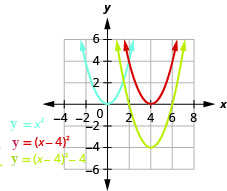
We list the steps to take a graph a quadratic equation using transformations here.
Graph a Quadratic equation Using Transformations
- Rewrite the equation in \(y=a(x-h)^{2}+k\) form by completing the square.
- Graph the equation using transformations.
Graph \(y=-2x^{2}-4x+2\) by using transformations.
Solution:
Step 1: Rewrite the equation in \(y=a(x-h)^{2}+k\) vertex form by completing the square.
|
\(y=-2x^2-4x+2\) |
|
| Separate the \(x\) terms from the constant. |
\(y=-2x^2-4x\quad+2\) |
| We need the coefficient of \(x^{2}\) to be one. We factor \(-2\) from the \(x\)-terms. |
\(y=-2(x^2+2x\quad)+2\) |
| Take half of \(2\) and then square it to complete the square. \((\dfrac{1}{2}\cdot 2)^{2}=1\) | |
| We add \(1\) to complete the square in the parentheses, but the parentheses is multiplied by \(-2\). So we are really adding \(-2\). To not change the value of the equation we add \(2\). |
\(y=-2((x^2+2x+1)-1)+2\) \(y=-2(x^2+2x+1)+2+2\) |
| Rewrite the trinomial as a square ad subtract the constants. |
\(y=-2(x+1)^2+4\) |
| The equation is now in the \(y=a(x-h)^{2}+k\) form. |
\(y=a(x-h)^2+k\) \(y=-2(x+1)^2+4\) |
Step 2: Graph the equation using transformations.

We first draw the graph of \(y=x^{2}\) on the grid.


Graph \(y=-3x^{2}+12x-4\) by using transformations.
- Answer
-
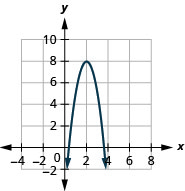
Graph \(y=−2x^{2}+12x−9\) by using transformations.
- Answer
-
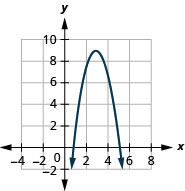
Now that we have completed the square to put a quadratic equation into \(y=a(x−h)^{2}+k\) form, we can also use this technique to graph the equation using its properties as in the previous section.
If we look back at the last few examples, we see that the vertex is related to the constants \(h\) and \(k\).
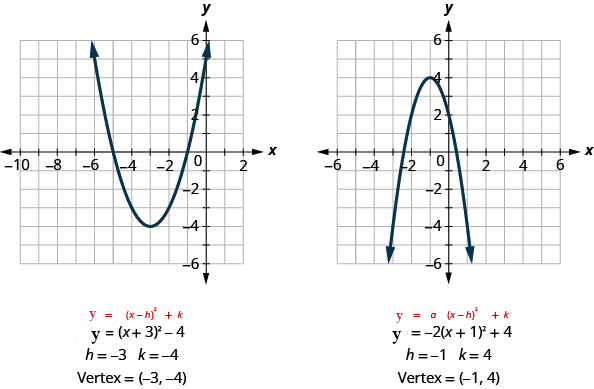
In each case, the vertex is \((h,k)\). Also the axis of symmetry is the line \(x=h\).
We rewrite our steps for graphing a quadratic equation using properties for when the equation is in \(y=a(x−h)^{2}+k\) form.
Graph a Quadratic equation in the Form \(y=a(x-h)^{2}+k\) Using Properties
- Rewrite the equation \(y=a(x-h)^{2}+k\) form.
- Determine whether the parabola opens upward, \(a>0\), or downward, \(a<0\).
- Find the axis of symmetry, \(x=h\).
- Find the vertex, \((h,k)\).
- Find the \(y\)-intercept. Find the point symmetric to the \(y\)-intercept across the axis of symmetry.
- Find the \(x\)-intercepts.
- Graph the parabola.
- Rewrite \(y=2 x^{2}+4 x+5\) in \(y=a(x-h)^{2}+k\) form
- Graph the equation using properties
Solution:
| Rewrite the equation in \(y=a(x-h)^{2}+k\) form by completing the square. | \(y=2 x^{2}+4 x+5\) |
| \(y=2\left(x^{2}+2 x\right)+5\) | |
| \(y=2\left(x^{2}+2 x+1\right)+5-2\) | |
| \(y=2(x+1)^{2}+3\) | |
| Identify the constants \(a, h, k\). | |
| Since \(a=2\), the parabola opens upward. |  |
| The axis of symmetry is \(x=h\). | The axis of symmetry is \(x=-1\). |
| The vertex is \((h,k)\). | The vertex is \((-1,3)\). |
| Find the \(y\)-intercept by finding \(f(0)\). | \(f(0)=2 \cdot 0^{2}+4 \cdot 0+5\) |
| \(f(0)=5\) | |
| \(y\)-intercept \((0,5)\) | |
| Find the point symmetric to \((0,5)\) across the axis of symmetry. | \((-2,5)\) |
| Find the \(x\)-intercepts. | The discriminant is negative, so there are no \(x\)-intercepts. Graph the parabola. |
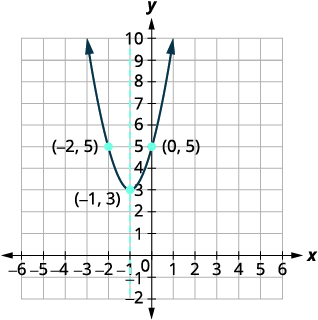 |
- Rewrite \(y=3 x^{2}-6 x+5\) in \(y=a(x-h)^{2}+k\) form
- Graph the equation using properties
- Answer
-
- \(y=3(x-1)^{2}+2\)
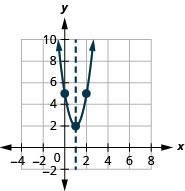
Figure 9.7.66
- Rewrite \(y=-2 x^{2}+8 x-7\) in \(y=a(x-h)^{2}+k\) form
- Graph the equation using properties
- Answer
-
- \(y=-2(x-2)^{2}+1\)
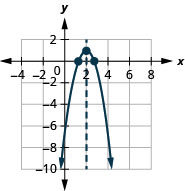
Figure 9.7.67
Challenge section:
Find a Quadratic Equation from its Graph
So far we have started with a equation and then found its graph.
Now we are going to reverse the process. Starting with the graph, we will find the equation.
Determine the quadratic equation whose graph is shown.
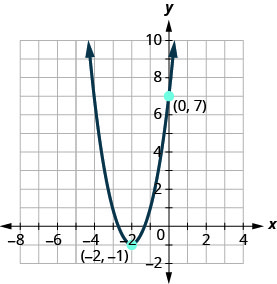
Solution:
Since it is quadratic, we start with the \(y=a(x−h)^{2}+k\) form.
The vertex, \((h,k)\), is \((−2,−1)\) so \(h=−2\) and \(k=−1\).
\(y=a(x-(-2))^{2}-1\)
To find \(a\), we use the \(y\)-intercept, \((0,7)\).
So \(f(0)=7\).
\(7=a(0+2)^{2}-1\)
Solve for \(a\).
\(\begin{array}{l}{7=4 a-1} \\ {8=4 a} \\ {2=a}\end{array}\)
Write the equation.
\(y=a(x-h)^{2}+k\)
Substitute in \(h=-2, k=-1\) and \(a=2\).
\(y=2(x+2)^{2}-1\)
Write the quadratic equation in \(y=a(x−h)^{2}+k\) form whose graph is shown.
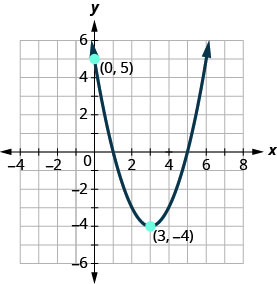
- Answer
-
\(y=(x-3)^{2}-4\)
Determine the quadratic equation whose graph is shown.
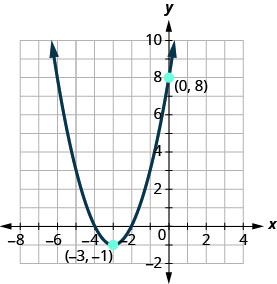
- Answer
-
\(y=(x+3)^{2}-1\)
Key Concepts
- Graph a Quadratic equation of the form \(y=x^{2}+k\) Using a Vertical Shift
- The graph of \(y=x^{2}+k\) shifts the graph of \(y=x^{2}\) vertically \(k\) units.
- If \(k>0\), shift the parabola vertically up \(k\) units.
- If \(k<0\), shift the parabola vertically down \(|k|\) units.
- The graph of \(y=x^{2}+k\) shifts the graph of \(y=x^{2}\) vertically \(k\) units.
- Graph a Quadratic equation of the form \(y=(x−h)^{2}\) Using a Horizontal Shift
- The graph of \(y=(x−h)^{2}\) shifts the graph of \(y=x^{2}\) horizontally \(h\) units.
- If \(h>0\), shift the parabola horizontally left \(h\) units.
- If \(h<0\), shift the parabola horizontally right \(|h|\) units.
- The graph of \(y=(x−h)^{2}\) shifts the graph of \(y=x^{2}\) horizontally \(h\) units.
- Graph of a Quadratic equation of the form \(y=ax^{2}\)
- The coefficient \(a\) in the equation \(y=ax^{2}\) affects the graph of \(y=x^{2}\) by stretching or compressing it.
If \(0<|a|<1\), then the graph of \(y=ax^{2}\) will be “wider” than the graph of \(y=x^{2}\).
If \(|a|>1\), then the graph of \(y=ax^{2}\) will be “skinnier” than the graph of \(y=x^{2}\).
- The coefficient \(a\) in the equation \(y=ax^{2}\) affects the graph of \(y=x^{2}\) by stretching or compressing it.
- How to graph a quadratic equation using transformations
- Rewrite the equation in \(y=a(x−h)^{2}+k\) form by completing the square.
- Graph the equation using transformations.
- Graph a quadratic equation in the vertex form \(y=a(x−h)^{2}+k\) using properties
- Rewrite the equation in \(y=a(x−h)^{2}+k\) form.
- Determine whether the parabola opens upward, \(a>0\), or downward, \(a<0\).
- Find the axis of symmetry, \(x=h\).
- Find the vertex, \((h,k)\).
- Find the \(y\)-intercept. Find the point symmetric to the \(y\)-intercept across the axis of symmetry.
- Find the \(x\)-intercepts, if possible.
- Graph the parabola.
Practice Makes Perfect
In the following exercises,
- Graph the quadratic equations on the same rectangular coordinate system
- Describe what effect adding a constant, \(k\), to the equation has on the basic parabola.
- \(y=x^{2}, y=x^{2}+4, \text { and } y=x^{2}-4\)
- \(y=x^{2}, y=x^{2}+7, \text { and } y=x^{2}-7\)
- Answer
-
1.
Use DESMOS- The graph of \(y=x^{2}+4\) is the same as the graph of \(y=x^{2}\) but shifted up \(4\) units. The graph of \(y=x^{2}-4\) is the same as the graph of \(y=x^{2}\) but shift down \(4\) units.
In the following exercises, graph each equation using a vertical shift.
- \(y=x^{2}+3\)
- \(y=x^{2}-7\)
- \(y=x^{2}+2\)
- \(y=x^{2}+5\)
- \(y=x^{2}-4\)
- \(y=x^{2}-5\)
- Answer
-
3.
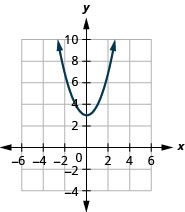
Figure 9.7.72 5.
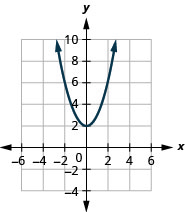
Figure 9.7.73 7.
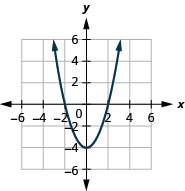
Figure 9.7.74
In the following exercises,
- Graph the quadratic equations on the same rectangular coordinate system
- Describe what effect adding a constant, \(h\), inside the parentheses has
- \(y=x^{2}, y=(x-3)^{2}, \text { and } y=(x+3)^{2}\)
- \(y=x^{2}, y=(x+4)^{2}, \text { and } y=(x-4)^{2}\)
- Answer
-
9.
Use DESMOS- The graph of \(y=(x−3)^{2}\) is the same as the graph of \(y=x^{2}\) but shifted right \(3\) units. The graph of \(y=(x+3)^{2}\) is the same as the graph of \(y=x^{2}\) but shifted left \(3\) units.
In the following exercises, graph each equation using a horizontal shift.
- \(y=(x-2)^{2}\)
- \(y=(x-1)^{2}\)
- \(y=(x+5)^{2}\)
- \(y=(x+3)^{2}\)
- \(y=(x-5)^{2}\)
- \(y=(x+2)^{2}\)
- Answer
-
11.
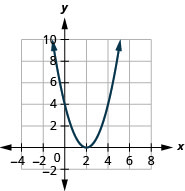
Figure 9.7.76 13.
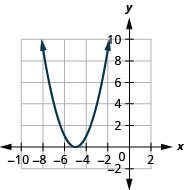
Figure 9.7.77 15.
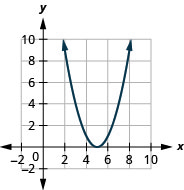
Figure 9.7.78
In the following exercises, graph each equation using transformations.
- \(y=(x+2)^{2}+1\)
- \(y=(x+4)^{2}+2\)
- \(y=(x-1)^{2}+5\)
- \(y=(x-3)^{2}+4\)
- \(y=(x+3)^{2}-1\)
- \(y=(x+5)^{2}-2\)
- \(y=(x-4)^{2}-3\)
- \(y=(x-6)^{2}-2\)
- Answer
-
17.
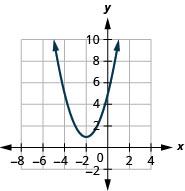
Figure 9.7.79 19.
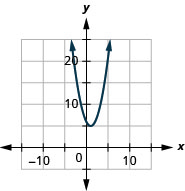
Figure 9.7.80 21.
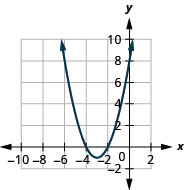
Figure 9.7.81 23.
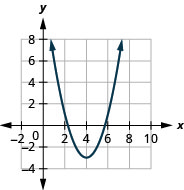
Figure 9.7.82
In the following exercises, graph each equation.
- \(y=-2 x^{2}\)
- \(y=4 x^{2}\)
- \(y=-4 x^{2}\)
- \(y=-x^{2}\)
- \(y=\dfrac{1}{2} x^{2}\)
- \(y=\dfrac{1}{3} x^{2}\)
- \(y=\dfrac{1}{4} x^{2}\)
- \(y=-\dfrac{1}{2} x^{2}\)
- Answer
-
25.
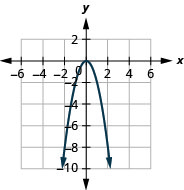
Figure 9.7.83 27.
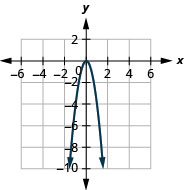
Figure 9.7.84 29.

Figure 9.7.85 31.
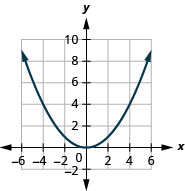
Figure 9.7.86
In the following exercises, rewrite each equation in the \(y=a(x−h)^{2}+k\) form by completing the square.
- \(y=-3 x^{2}-12 x-5\)
- \(y=2 x^{2}-12 x+7\)
- \(y=3 x^{2}+6 x-1\)
- \(y=-4 x^{2}-16 x-9\)
- Answer
-
33. \(y=-3(x+2)^{2}+7\)
35. \(y=3(x+1)^{2}-4\)
In the following exercises,
- Rewrite each equation in \(y=a(x−h)^{2}+k\) form
- Graph it by using transformations
- \(y=x^{2}+6 x+5\)
- \((x)=x^{2}+4 x-12\)
- \(y=x^{2}+4 x-12\)
- \(y=x^{2}-6 x+8\)
- \(y=x^{2}-6 x+15\)
- \(y=x^{2}+8 x+10\)
- \(y=-x^{2}+8 x-16\)
- \(y=-x^{2}+2 x-7\)
- \(y=-x^{2}-4 x+2\)
- \(y=-x^{2}+4 x-5\)
- \(y=5 x^{2}-10 x+8\)
- \(y=3 x^{2}+18 x+20\)
- \(y=2 x^{2}-4 x+1\)
- \(y=3 x^{2}-6 x-1\)
- \(y=-2 x^{2}+8 x-10\)
- \(y=-3 x^{2}+6 x+1\)
- Answer
-
37.
- y=(x+3)^{2}-4
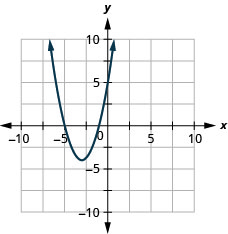
Figure 9.7.87 39.
- \(y=(x+2)^{2}-1\)
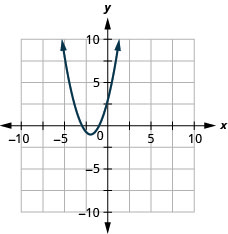
Figure 9.7.88 41.
- \(y=(x-3)^{2}+6\)
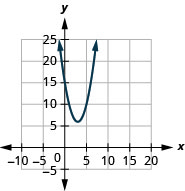
Figure 9.7.89 43.
- \(y=-(x-4)^{2}+0\)

Figure 9.7.90 45.
- \(y=-(x+2)^{2}+6\)
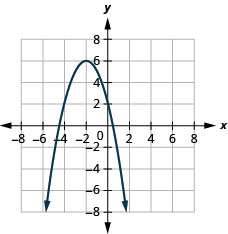
Figure 9.7.91 47.
- \(y=5(x-1)^{2}+3\)
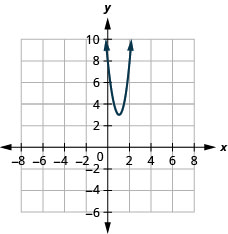
Figure 9.7.92 49.
- \(y=2(x-1)^{2}-1\)
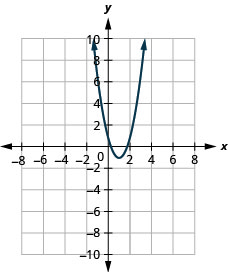
Figure 9.7.93 51.
- \(y=-2(x-2)^{2}-2\)
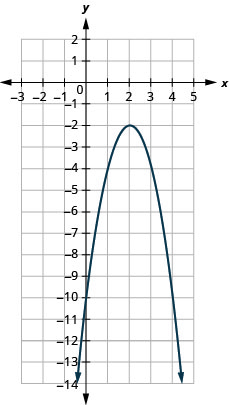
Figure 9.7.94
In the following exercises,
- Rewrite each equation in \(y=a(x−h)^{2}+k\) form
- Graph it using properties
- \(y=2 x^{2}+4 x+6\)
- \(y=3 x^{2}-12 x+7\)
- \(y=-x^{2}+2 x-4\)
- \(y=-2 x^{2}-4 x-5\)
- Answer
-
53.
- \(y=2(x+1)^{2}+4\)
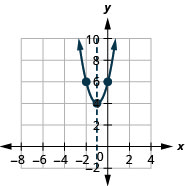
Figure 9.7.95 55.
- \(y=-(x-1)^{2}-3\)
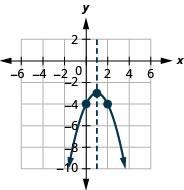
Figure 9.7.96
In the following exercises, match the graphs to one of the following equations:
- \(y=x^{2}+4\)
- \(y=x^{2}-4\)
- \(y=(x+4)^{2}\)
- \(y=(x-4)^{2}\)
- \(y=(x+4)^{2}-4\)
- \(y=(x+4)^{2}+4\)
- \(y=(x-4)^{2}-4\)
- \(y=(x-4)^{2}+4\)
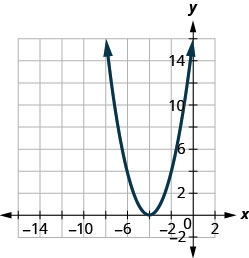
Figure 9.7.97
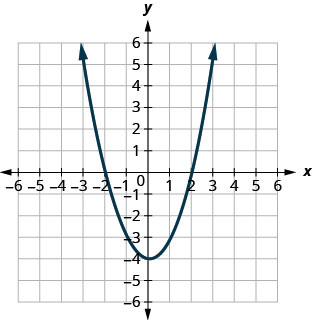
Figure 9.7.98
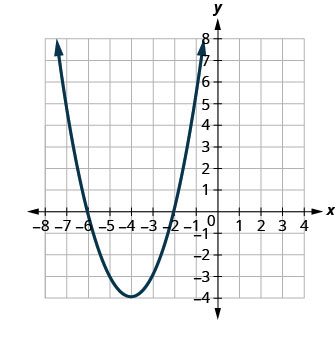
Figure 9.7.99
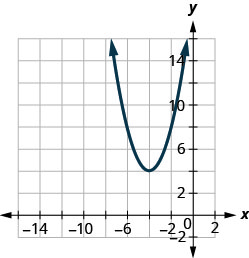
Figure 9.7.100
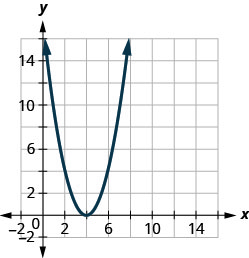
Figure 9.7.101

Figure 9.7.102
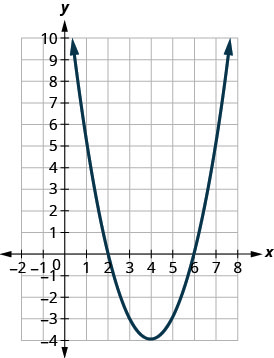
Figure 9.7.103

Figure 9.7.104
- Answer
-
57. c
59. e
61. d
63. g
In the following exercises, write the quadratic equation in \(y=a(x−h)^{2}+k\) form whose graph is shown.
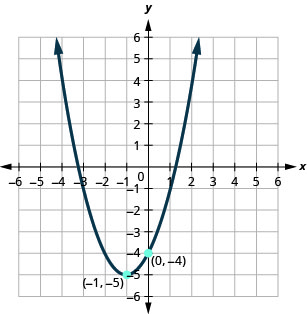
Figure 9.7.105
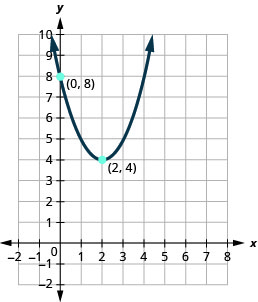
Figure 9.7.106
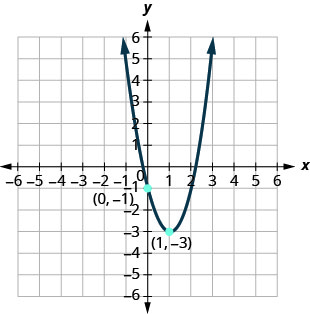
Figure 9.7.107
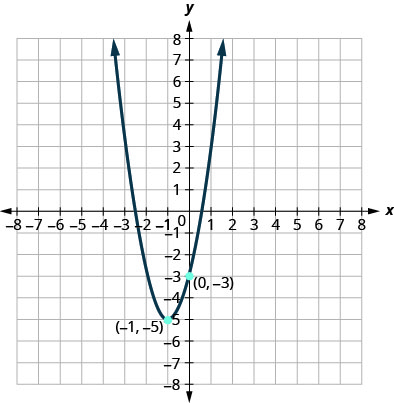
Figure 9.7.108
- Answer
-
65. \(y=(x+1)^{2}-5\)
67. \(y=2(x-1)^{2}-3\)
- Graph the quadratic equation \(y=x^{2}+4x+5\) first using the properties as we did in the last section and then graph it using transformations. Which method do you prefer? Why?
- Graph the quadratic equation \(y=2x^{2}−4x−3\) first using the properties as we did in the last section and then graph it using transformations. Which method do you prefer? Why?
- Answer
-
69. Answers may vary.
Self Check
a. After completing the exercises, use this checklist to evaluate your mastery of the objectives of this section.
| I can... | Confidently | With some help | No--I don't get it! |
| graph quadratic equations of the form \(y=x^2+k\). | |||
| graph quadratic equations of the form \(y=(x-h)^2\). | |||
| graph quadratic equations of the form \(y=ax^2\). | |||
| graph quadratic equations using transformations. | |||
| find a quadratic equation from its graph. |
b. After looking at the checklist, do you think you are well-prepared for the next section? Why or why not?


